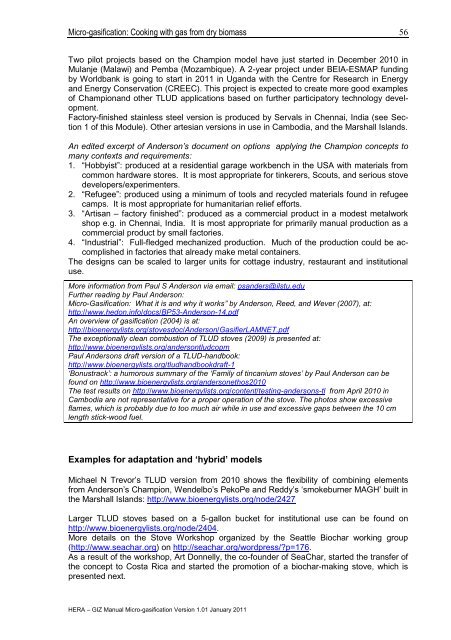Micro-gasification: Cooking with gas from biomass - Amper
Micro-gasification: Cooking with gas from biomass - Amper
Micro-gasification: Cooking with gas from biomass - Amper
Create successful ePaper yourself
Turn your PDF publications into a flip-book with our unique Google optimized e-Paper software.
<strong>Micro</strong>-<strong><strong>gas</strong>ification</strong>: <strong>Cooking</strong> <strong>with</strong> <strong>gas</strong> <strong>from</strong> dry <strong>biomass</strong><br />
Two pilot projects based on the Champion model have just started in December 2010 in<br />
Mulanje (Malawi) and Pemba (Mozambique). A 2-year project under BEIA-ESMAP funding<br />
by Worldbank is going to start in 2011 in Uganda <strong>with</strong> the Centre for Research in Energy<br />
and Energy Conservation (CREEC). This project is expected to create more good examples<br />
of Championand other TLUD applications based on further participatory technology development.<br />
Factory-finished stainless steel version is produced by Servals in Chennai, India (see Section<br />
1 of this Module). Other artesian versions in use in Cambodia, and the Marshall Islands.<br />
An edited excerpt of Anderson’s document on options applying the Champion concepts to<br />
many contexts and requirements:<br />
1. ―Hobbyist‖: produced at a residential garage workbench in the USA <strong>with</strong> materials <strong>from</strong><br />
common hardware stores. It is most appropriate for tinkerers, Scouts, and serious stove<br />
developers/experimenters.<br />
2. ―Refugee‖: produced using a minimum of tools and recycled materials found in refugee<br />
camps. It is most appropriate for humanitarian relief efforts.<br />
3. ―Artisan – factory finished‖: produced as a commercial product in a modest metalwork<br />
shop e.g. in Chennai, India. It is most appropriate for primarily manual production as a<br />
commercial product by small factories.<br />
4. ―Industrial‖: Full-fledged mechanized production. Much of the production could be accomplished<br />
in factories that already make metal containers.<br />
The designs can be scaled to larger units for cottage industry, restaurant and institutional<br />
use.<br />
More information <strong>from</strong> Paul S Anderson via email: psanders@ilstu.edu<br />
Further reading by Paul Anderson:<br />
<strong>Micro</strong>-Gasification: What it is and why it works” by Anderson, Reed, and Wever (2007), at:<br />
http://www.hedon.info/docs/BP53-Anderson-14.pdf<br />
An overview of <strong><strong>gas</strong>ification</strong> (2004) is at:<br />
http://bioenergylists.org/stovesdoc/Anderson/GasifierLAMNET.pdf<br />
The exceptionally clean combustion of TLUD stoves (2009) is presented at:<br />
http://www.bioenergylists.org/andersontludcopm<br />
Paul Andersons draft version of a TLUD-handbook:<br />
http://www.bioenergylists.org/tludhandbookdraft-1<br />
‘Bonustrack’: a humorous summary of the ‘Family of tincanium stoves’ by Paul Anderson can be<br />
found on http://www.bioenergylists.org/andersonethos2010<br />
The test results on http://www.bioenergylists.org/content/testing-andersons-tl <strong>from</strong> April 2010 in<br />
Cambodia are not representative for a proper operation of the stove. The photos show excessive<br />
flames, which is probably due to too much air while in use and excessive gaps between the 10 cm<br />
length stick-wood fuel.<br />
Examples for adaptation and „hybrid‟ models<br />
Michael N Trevor‘s TLUD version <strong>from</strong> 2010 shows the flexibility of combining elements<br />
<strong>from</strong> Anderson‘s Champion, Wendelbo‘s PekoPe and Reddy‘s ‗smokeburner MAGH‘ built in<br />
the Marshall Islands: http://www.bioenergylists.org/node/2427<br />
Larger TLUD stoves based on a 5-gallon bucket for institutional use can be found on<br />
http://www.bioenergylists.org/node/2404.<br />
More details on the Stove Workshop organized by the Seattle Biochar working group<br />
(http://www.seachar.org) on http://seachar.org/wordpress/?p=176.<br />
As a result of the workshop, Art Donnelly, the co-founder of SeaChar, started the transfer of<br />
the concept to Costa Rica and started the promotion of a biochar-making stove, which is<br />
presented next.<br />
HERA – GIZ Manual <strong>Micro</strong>-<strong><strong>gas</strong>ification</strong> Version 1.01 January 2011<br />
56
















